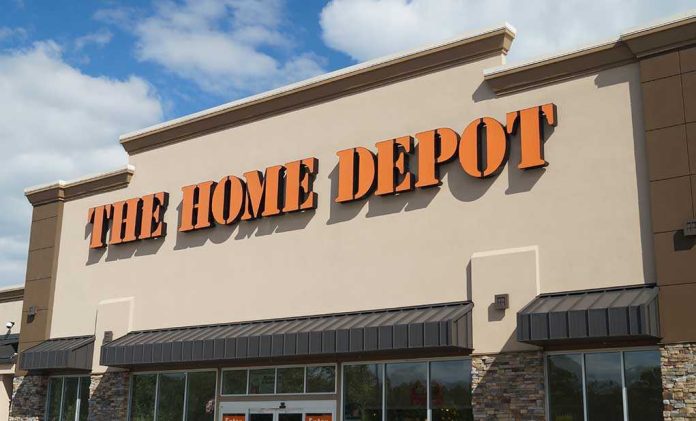
Home Depot’s massive $5.5 billion acquisition of GMS Inc. signals a decisive end to America’s era of cheap, abundant labor as major corporations prepare for a future where automation trumps immigration.
Key Takeaways
- Home Depot’s $5.5 billion acquisition of GMS Inc. represents a strategic pivot away from labor-dependent operations toward automation and supply chain optimization
- This follows an $18 billion purchase of SRS Distribution, showing Home Depot’s commitment to building a labor-light, capital-intensive business model
- The acquisition will integrate GMS’s 300+ distribution centers with SRS’s national footprint, creating a network of 1,200 locations and 8,000 trucks
- The move reflects adaptation to reduced immigration under President Trump’s policies and rising opposition to mass migration
- This strategic shift emphasizes domestic production and vertical integration to reduce dependence on foreign suppliers amid ongoing U.S.-China trade tensions
A Strategic Shift from Labor to Automation
Home Depot’s acquisition of GMS Inc. for $5.5 billion through its subsidiary SRS Distribution marks a fundamental transformation in American business strategy. The home improvement giant is redirecting its focus toward a future where labor is both scarce and expensive, investing heavily in automation and supply chain optimization rather than continuing to rely on low-skilled workers. This follows Home Depot’s previous $18 billion purchase of SRS Distribution, demonstrating a clear pattern of moving away from traditional labor-intensive operations toward capital-intensive business models with higher margins and lower labor dependence.
“The golden age for employers is coming to an end,” said Adrian Wooldridge, British journalist and historian.
The timing of this strategic shift aligns with broader economic and political changes in America. Under President Trump’s leadership, immigration policies have tightened significantly, and public sentiment has increasingly turned against mass immigration. These factors have combined to create an environment where businesses can no longer assume an endless supply of low-cost labor will be available. Instead of lobbying for expanded visa programs, forward-thinking companies like Home Depot are investing in infrastructure that minimizes their labor needs through automation, centralization, and strategic acquisitions.
Building a Resilient Domestic Supply Chain
The acquisition integrates GMS’s network of 320 distribution centers, specializing in drywall, framing, and tool services, with SRS’s established national footprint. This strategic consolidation gives Home Depot unprecedented control over approximately 1,200 locations and a fleet of 8,000 trucks. The company’s $110-per-share offer for GMS, which outbid QXO’s $5 billion proposal, underscores the value Home Depot places on dominating the contractor market segment and securing its supply chain against disruptions.
This move comes amid escalating U.S.-China trade tensions, which have resulted in increased tariffs on Chinese building materials and corresponding rises in costs. By consolidating domestic suppliers and distribution networks, Home Depot is positioning itself to reduce reliance on foreign materials and build resilience against geopolitical uncertainties. The strategy focuses on volume, efficiency, and adaptability, creating a business model that can thrive despite labor market constraints and international trade complications.
Automation as the Future of Construction and Logistics
The broader trend in construction and logistics industries is moving decisively toward automation and centralization, minimizing human touchpoints throughout the supply chain. Home Depot’s acquisitions reflect this industry-wide shift, as companies adapt to a labor-scarce environment by investing in technology and infrastructure rather than human resources. The traditional model of importing workers to meet labor demands is being replaced by investments in AI, automation, and domestic training programs designed to rebuild American labor supply chains through education and apprenticeships.
Wall Street analysts may misinterpret these consolidation deals as potential antitrust concerns, missing the fundamental driver: adapting to labor scarcity. What’s emerging instead is a new business paradigm where scale, automation, and vertical integration provide competitive advantages. Companies with strong financial positions are best positioned to make these capital-intensive investments in reshoring operations and building domestic supply networks, while smaller firms may struggle to adapt to the changing landscape.
Implications for the American Economy
Home Depot’s strategic pivot exemplifies how major corporations are adapting to President Trump’s economic policies, which encourage domestic investment and production through tariffs and immigration reforms. Rather than resisting these changes, forward-looking businesses are embracing them, restructuring their operations to thrive in an environment where domestic production and automation take precedence over imported goods and labor. This transition may initially require significant capital expenditure, but positions companies for long-term sustainability in a changing economic landscape.
For investors, the message is clear: focus on companies demonstrating vertical integration, domestic production capabilities, and strong contractor relationships. These businesses are positioning themselves to weather geopolitical storms and labor market fluctuations while maintaining profitability. Home Depot’s acquisitions of GMS and SRS Distribution represent not just expansions of its business, but fundamental strategic realignments in response to the new realities of the American economy under President Trump’s leadership.













